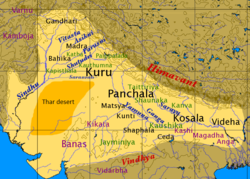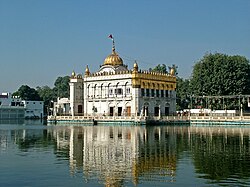Punjabi Hindus
 | |
| Total population | |
|---|---|
| 11 million | |
| Regions with significant populations | |
| East Punjab, Chandigarh, Delhi, Haryana, Himachal Pradesh, West Punjab, Jammu Division | |
| Languages | |
| Punjabi and Punjabi dialects, Hindi, and English | |
| Religion | |
| Hinduism (incld. Udasi syncretic sect) | |
| Related ethnic groups | |
| Punjabi Sikhs, Punjabi Muslims, Punjabi Christians |
Punjabi Hindus are an Indo-Aryan group. Adherents of Hinduism, they identify linguistically, culturally, and genealogically as Punjabis. While Punjabi Hindus are mostly found in India today, many have ancestry in the entire Punjab region, split between India and Pakistan.
In Indian state of Punjab, they makeup approximately 38.5% of the state's population and are a majority in the Doaba region.
Presently, there is a small Punjabi Hindu community that remains in Pakistan, concentrated in cities such as Lahore[1][2] and in rural districts across southern Punjab such as Bahawalpur and Rahim Yar Khan.[3] There is also large diaspora communities in many countries including in Canada, Australia, the United States, and the United Kingdom.
Punjabi Hindu community[edit | edit source]
Prominent Indian nationalists from Punjab, such as Lala Lajpat Rai, belonged to the Punjabi Hindu community. Religious reform groups such as the Arya Samaj sect were active in propagating their message in Punjab.[4] During the early part of the 20th century, the Samaj and organisations inspired by it, such as Jat Pat Todak Mandal, were active in campaigning against caste discrimination.[5] Other activities in which the Samaj engaged included campaigning for the acceptance of widow remarriage and women's education.[6]
History[edit | edit source]
Ancient and Medieval[edit | edit source]


Punjab during Mahabharata times was known as Panchanada.[7][8] Punjab was part of the Indus Valley Civilization, a culture which is more than 5000 years old.[9] The main site in Punjab was the city of Harrapa. The Indus Valley Civilization spanned much of what is today India and Pakistan and eventually evolved into the Indo-Aryan civilization. The arrival of the Indo-Aryans led to the flourishing of the Vedic civilization along the length of the Indus River. This civilization shaped subsequent cultures in South Asia and Afghanistan. Punjab was part of the great ancient empires including the Gandhara Mahajanapadas, Achaemenids, Macedonians, Mauryas, Kushans, Guptas, Hindu Shahi, Gurjara-Pratihara and old Rajputana.[10][11][12] Agriculture flourished and trading cities (such as Multan, Lahore, Jalandhar, and Rupnagar) grew in wealth.
Due to its location, the Punjab region came under constant attack and influence from the west and witnessed centuries of foreign invasions by the Greeks, Kushans, Scythians, Turks, Arabs, and Afghans. The city of Taxila, claimed to have been founded by Taksh the son of Bharat who was the brother of Ram. It was reputed to house the oldest university in the world,[13] Takshashila University. One of the teachers was the great Vedic thinker and politician Chanakya. Taxila was a great centre of learning and intellectual discussion during the Maurya Empire. It is a UN World Heritage site, valued for its archaeological and religious history.[14]
1947 Partition[edit | edit source]
An estimated 2.7 million Punjabi Hindus migrated from West Punjab and North-West Frontier Province (present-day Pakistan) to East Punjab & Delhi (present-day India) during the Partition.[15]
This split the former British province of Punjab between the Dominion of India and the Dominion of Pakistan. The mostly Muslim western part of the province became Pakistan's Punjab province; the mostly Sikh and Hindu eastern part became India's East Punjab state (later divided into the new states of Punjab, Haryana and Himachal Pradesh). Many Hindus and Sikhs lived in the west, and many Muslims lived in the east, and the fears of all such minorities were so great that the Partition saw many people displaced and much intercommunal violence. Some have described the violence in Punjab as a retributive genocide.[16]
The newly formed governments had not anticipated, and were completely unequipped for, a two-way migration of such staggering magnitude, and massive violence and slaughter occurred on both sides of the new India-Pakistan border. Estimates of the number of deaths vary, with low estimates at 200,000 and high estimates at 2,000,000. The worst case of violence among all regions is concluded to have taken place in Punjab.[17][18][19][20]
Punjabi Suba and trifurcation of Punjab[edit | edit source]
After Partition, Sikh leaders and political parties demanded a "Punjabi Suba" (Punjabi Province) where Punjabi language written in the Sikh Gurumukhi script would be the language of the state in North India.
At the instigation of the Arya Samaj, many Punjabi Hindus in present-day Ambala, Una and Sirsa stated Hindi as their mother tongue in the censuses of 1951 and 1961. Some areas of the erstwhile East Punjab state where Hindi, Haryanvi and Western Pahari speaking Hindus formed the majority became part of the newly created states of Haryana and Himachal Pradesh where Hindi was declared the state language. This was in contrast with the primarily Punjabi-speaking locals in some regions of the newly created states.[21] A direct result of the trifurcation of East Punjab into three states made Punjab a Sikh-majority state in India. Today, Punjabi Hindus makeup approximately 38.5% population of present Punjab State of India.[22][23]
Culture and Religion[edit | edit source]

Hinduism in Punjab, as in many other parts of India, has adapted over time and has become a synthesis of culture and history. It centres on using Dharma to purify the soul (Atman) and to connect with a greater "eternal energy" (Paramātmā).[citation needed] Hindus do this while acknowledging the concept of Brahman or "external energy", which is metaphysically believed to be the single binding energy behind the diversity that exists in the universe. In Punjab, like in many other regions of Northern India, Hindus revere ancient texts that narrate stories of deities (Devas and Devis) that had reached their highest Paramātmā. Deities in Hinduism are honoured for their roles in ancient Indian history, as they were the upholders of the principles of Dharma in the past. Hindus believe that an Ishvara (supreme) Bhagavan (God) manifests itself through these Devas and Devis. Major deities worshiped include Rama and Sita from the Ramayana, Krishna and Radha from the Mahabharata, as well as the Trimurti and Tridevi of Shiva and Parvati, Vishnu and Lakshmi, and Brahma and Sarasvati, along with other prominent deities such as Durga Mata Ji, Ganesha and Hanuman.[24] Though, boundaries between major sects of Hinduism are extremely fluid, however Hindus of Punjab mostly follow Shaktism and Vaishnavism.[25]
As Hindus believe that Dharma is universal and evolves with time, many Hindus also value other spiritual paths and religious traditions. They believe that any traditions that are equally able to nurture one's Atman should be accepted and taught. Hinduism itself encourages any being to reach their own self-realization in their own unique way either through Bhagavan or through other means of devotion and meditation.[26]
Udasis[edit | edit source]
Udasi is a religious sect of ascetic sadhus centred in Punjab Region. The Udasis were key interpreters of the Sikh philosophy and the custodians of important Sikh shrines until the Akali movement. They brought many converts into the Sikh fold during the 18th and the early 19th centuries.[27] However, their religious practices border on a syncretism of Sikhism and Hinduism. When the Singh Sabha, dominated by Khalsa Sikhs, redefined the Sikh identity in the early 20th century, the Udasi mahants were expelled from the Sikh shrines. Since then, the Udasis have increasingly regarded themselves as Hindus rather than Sikhs.[28]
See also[edit | edit source]
- Hinduism in Punjab, Pakistan
- Hinduism and Sikhism
- Jainism in Punjab
- List of Hindu festivals in Punjab
- East Punjab
References[edit | edit source]
- ↑ "Hindu community celebrates Diwali across Punjab". The Express Tribune. 8 November 2018. Retrieved 18 December 2020.
- ↑ "Dussehra celebrated at Krishna Mandir". The Express Tribune. 23 October 2015. Retrieved 18 December 2020.
- ↑ Dharmindar Balach (17 August 2017). "Pakistani Hindus celebrate Janmashtami with fervour". Daily Times. Retrieved 10 August 2021.
- ↑ Raj Kumar (2004). Essays on Social Reform Movements. Discovery Publishing House. pp. 3–5. ISBN 978-81-7141-792-6.
- ↑ Rajivlochan, M. (2014). Coping with Exclusions the Non-Political Way. Mapping Social Exclusion in India: Caste, Religion and Borderlands. pp. 82–83.
- ↑ Kishwar, Madhu (26 April 1986). "Arya Samaj and Women's Education: Kanya Mahavidyalaya, Jalandhar". Economic and Political Weekly. 21 (17): WS9–WS24. JSTOR 4375593.
- ↑ Gazetteer of the Bombay Presidency ... – Google Books
- ↑ Gazetteer of the Bombay Presidency ..., Volume 1, Part 1-page-11
- ↑ Punjab History – history of Punjab
- ↑ McGregor, Ronald Stuart (1984). Hindi Literature from Its Beginnings to the Nineteenth Century. Harrassowitz. ISBN 978-3-447-02413-6.
- ↑ Gokhale, Balkrishna Govind (1995). Ancient India: History and Culture. Popular Prakashan. ISBN 978-81-7154-694-7.
- ↑ Bharadwaj. Study Package For Clat. Tata McGraw-Hill Education. ISBN 978-0-07-069937-3.
- ↑ Raman, J. Sri (19 July 2011). "Punjabi Hindus and Partition". The Hindu. ISSN 0971-751X. Retrieved 11 June 2021.
- ↑ Jalal 1998, p. 34.
- ↑ "The partition of India and retributive genocide in the Punjab, 1946–47: means, methods, and purposes" (PDF). Retrieved 19 December 2006.
- ↑ Brass 1974, p. 326.
- ↑ Talbot, Ian (2009). "Partition of India: The Human Dimension". Cultural and Social History. 6 (4): 403–410. doi:10.2752/147800409X466254. S2CID 147110854.
The number of casualties remains a matter of dispute, with figures being claimed that range from 200,000 to 2 million victims.
- ↑ D'Costa, Bina (2011). Nationbuilding, Gender and War Crimes in South Asia. Routledge. p. 53. ISBN 9780415565660.
- ↑ Butalia, Urvashi (2000). The Other Side of Silence: Voices From the Partition of India. Duke University Press.
- ↑ Sikand, Yoginder (2004). Muslims in India Since 1947: Islamic Perspectives on Inter-Faith Relations. Routledge. p. 5. ISBN 9781134378258.
- ↑ Chopra R. Love Is The Ultimate Winner Partridge, India 2013. p. 9072. ISBN 9781482800050 Accessed 3 February 2017.
- ↑ Lamba K. G. Dynamics of Punjabi Suba Movement Deep and Deep 1999. p. 90 ISBN 9788176291293 Accessed 3 February 2017.
- ↑ Grewal J. S. The Sikhs of the Punjab Cambridge University Press 1998. p. 187 ISBN 9780521637640 Accessed 3 February 2017.
- ↑ Tuteja, K.L. (1 June 2019). "'Hindi–Hindu' discourse in late colonial Punjab". Studies in People's History. 6 (1): 33–51. doi:10.1177/2348448919834776. ISSN 2348-4489.
- ↑ Brass 1974, p. 67.
- ↑ "Sikhism | History, Doctrines, Practice, & Literature". Encyclopedia Britannica. Retrieved 11 June 2021.
- ↑ Pashaura Singh. Fenech, Louis E. (March 2014). The Oxford handbook of Sikh studies. ISBN 978-0-19-969930-8. OCLC 874522334.
- ↑ Oberoi, Harjot. (1997). The Construction of religious boundaries : culture, identity, and diversity in the Sikh tradition. Delhi: Oxford University Press. ISBN 0-19-563780-1. OCLC 39001441.
Further reading[edit | edit source]
- Talib, Gurbachan (1950). Muslim League Attack on Sikhs and Hindus in the Punjab 1947. India: Shiromani Gurdwara Prabandhak Committee.
- Brass, Paul R. (1974). Language, Religion and Politics in North India. Cambridge University Press.
- Jalal, Ayesha (1998). "Nation, Reason and Religion: Punjab's Role in the Partition of India". Economic and Political Weekly. 33 (32): 2183–2190. ISSN 0012-9976. JSTOR 4407076.
External links[edit | edit source]
Template:Hinduism in India by regionTemplate:Religion in India topics